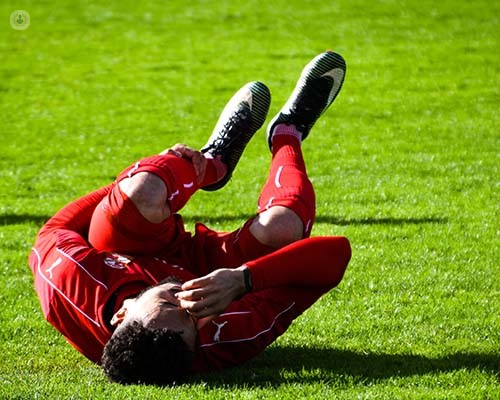5 signs that your knee pain is a meniscus tear
Escrito por:The Meniscii are crescent shaped fibrocartilage structures in the knee. The knee has two meniscii, the medial and lateral. The meniscus functions as a shock absorber for the knee, helping to share the load throughout the knee, maintaining the stability of the knee joint, as well as helping to distribute lubricating fluid around the joint. Any damage to the structural integrity of the meniscus is referred to as a meniscal tear. You can still walk on a torn meniscus, so how exactly do you recognise the signs of a meniscal tear?

What are the signs of a torn meniscus?
You’ve had pain in your knee for a few days now, but how do you know if the pain is due to a meniscal tear, and what should you do about it?
If you are experiencing the following symptoms, you should have your knee checked by a consultant orthopaedic surgeon.
- Pain at the line of the joint
- Exaggerated pain when putting weight on the knee or when twisting
- Pain when squatting
- Clicking sound when moving the knee, or the knee locking
- Knee swelling
What causes a torn meniscus?
There are two main ways that your meniscus could tear:
The first type is a degenerative meniscal tear which presents as pain in the knee that fails to settle. The pain an often be traced back to a specific event such as a sudden twisting movement, partaking in a new sport or starting a new exercise regime in the gym.
This type of tear occurs due to gradual wear over several years, which then tears from a low energy injury. This type of tear can also present due to having bowlegs.
The second type of meniscal tear is a traumatic high energy tear seen after an acute sporting injury. This type of tear may or may not be associated with other torn ligaments in the knee. The tear in this situation happens even though the meniscal tissue is healthy, and is the high-energy injury that causes the tear.
Depending on how soon after the injury the tear is diagnosed, meniscus tears are classified as acute (following a recent injury) or chronic (a long standing tear).
There are different types of meniscus tear, which will be diagnosed by the orthopaedic specialist, such as horizontal or vertical tears, partial or total thickness tear, and so on.
They are also classified as having sufficient blood supply to heal (red-on-red), having some blood supply (red-on-white), or having no blood supply and being unlikely to heal (white-on-white).
How is a meniscal tear diagnosed?
The diagnosis of meniscus tears can be made reasonably accurately based on the history of the problem and clinical examination. Commonly, you will have an MRI scan which gives vital information on the location and classification of the tear, as well as information about the rest of the knee, which has important implications in management of the tear.
How is it treated?
Treatment of meniscal tears depends on several factors. It is important that your surgeon decides the best option for you. Often the meniscus tear could highlight another problem with the knee, and treating the meniscus by itself is unlikely to be successful.
The aim of treating meniscal tears is to preserve the meniscus whenever possible, however some tears simply can’t be repaired and need to be partially removed (meniscectomy).
It may be necessary to replace the torn meniscus to preserve the rest of the joint. Some types of tears may be managed with physiotherapy alone.


